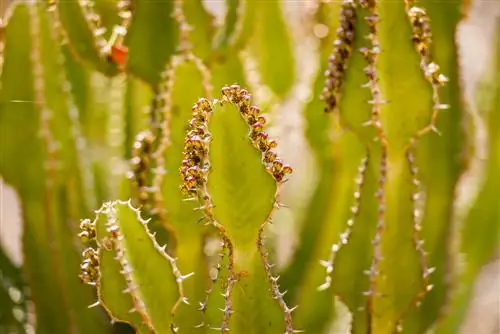- Author admin [email protected].
- Public 2023-12-16 16:46.
- Last modified 2025-01-23 11:21.
From a purely visual perspective, the spurge cactus (Euphorbia ingens) looks like a larger variant of the triangular spurge (Euphorbia trigona). Although this succulent tree is not really a cactus from a botanical perspective, the care requirements are quite similar.

How do I properly care for a Euphorbia ingens?
Euphorbia ingens needs water every 1-2 weeks, special cactus soil when repotting and little to no fertilizer. In winter, place at at least 15 degrees Celsius and water less. Wear gloves when cutting and watch out for pests such as spider mites, whiteflies or black weevils.
How often should Euphorbia be watered ingens?
Euphorbia ingens, which comes from southern Africa, copes well with “dry spells”. You should therefore only water the spurge cactus vigorously every one to two weeks, then remove excess water from the saucer and allow the soil to dry out until the next watering. During winter dormancy, this type of plant should only be watered once a month.
What should you consider when repotting the cactus spurge?
Do not use ordinary potting soil as a substrate when repotting, as this often contains high peat content and too many nutrients. With special cactus soil (€12.00 at Amazon), however, you can create the basis for he althy growth to a limited extent.
When and how can a cactus spurge be cut?
In general, most types of milkweed are not necessarily very cut-tolerant. However, with Euphorbia ingens, pruning may become necessary over time, as older specimens can grow up to 1 m per year under favorable conditions. Be sure to wear protective gloves to avoid coming into contact with the toxic milky juice when cutting. Large interfaces also require generous room ventilation.
Which pests can become a problem when caring for Euphorbia ingens?
The following pests are sometimes found on a spurge cactus and can weaken the plant:
- Whitefly larvae
- Spider mites
- Larvae of fungus gnats
- Bigmouth Weevil
Changes in site conditions such as higher humidity often help prevent pest infestation. If chemical aids from specialist retailers are avoided, many pests can also be brushed off with a soft soap solution.
What diseases commonly occur with cactus spurge?
It is not uncommon for waterlogging and over-fertilization to lead to rot due to fungal diseases. In such a case, many a spurge cactus can still be saved if it is cut off in time and re-rooted like an offshoot.
How is the spurge cactus optimally fertilized?
So that this type of milkweed doesn't grow over your head, little to no fertilization should be used. If at all, low doses of fertilizer should be applied during the summer outdoor season and not during the cooler winter dormancy.
How do you get the cactus spurge through the winter?
Since Euphorbia, like many other species of spurge, is not winter-hardy, after a summer outdoors it should be brought into a room that is at least 15 degrees Celsius warm with plenty of daylight and kept relatively dry there.
Tip
Due to the sometimes enormous growth, caring for Euphorbia ingens on a windowsill doesn't really make sense. To ensure that the plant does not grow too large too quickly, care should be taken to ensure a moderate supply of nutrients right from the start.






